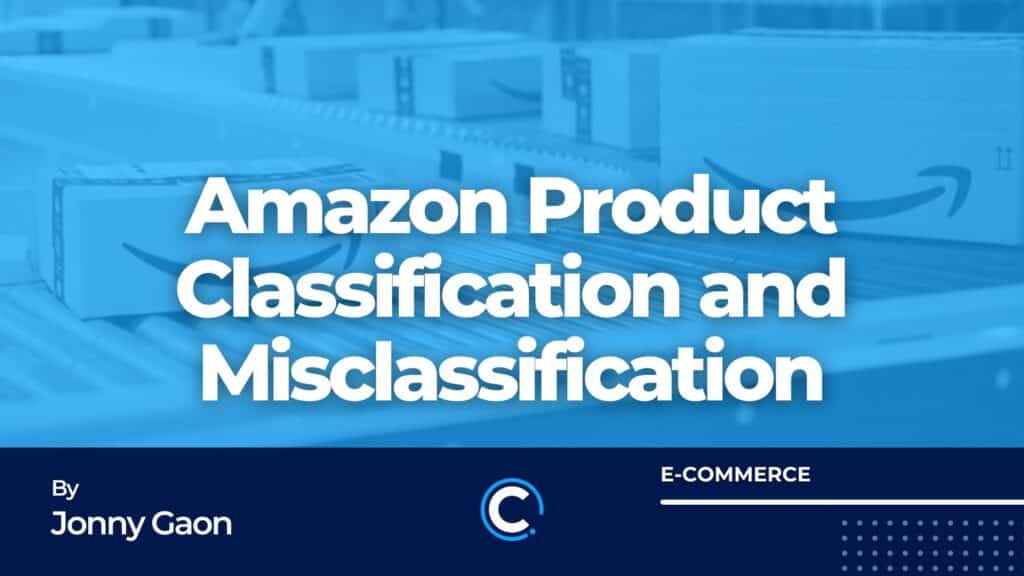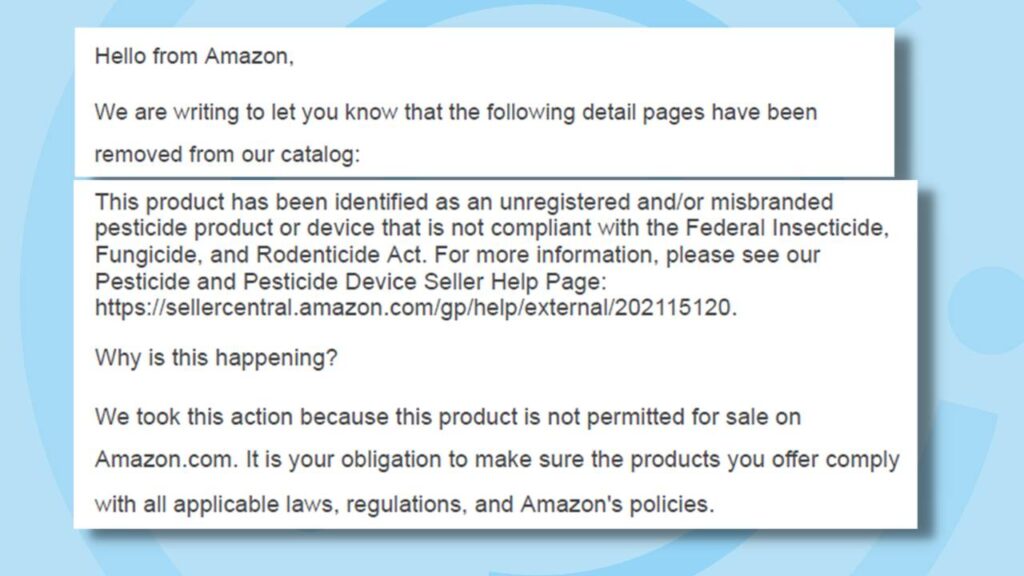
As experienced Amazon sellers will know, Amazon periodically culls listings for certain products. One day you are happily selling your face cream, a bar of soap, or kitchen utensil, the next you awaken to a scary Amazon notification, claiming that your product has been classified as dangerous, illegal, or otherwise restricted:

These events usually happen without warning on a wide scale basis, affecting many sellers at the same time, offering the same or similar products.
While you may find that many listings for the product in question are still active, you have likely fallen victim to Amazon’s aggressive bots and algorithms – an invisible army of code that silently patrols Amazon’s listing pages and remorselessly removes ASINs which include content that triggers their sensors. Anything from a solitary word, product claim or image in your listing or A+ content, even in the backend keywords/search terms, can trigger the bots to classify your product as a restricted item. Therefore, be very careful making any unsubstantiated claims or using any words that may be associated with a restricted product.
Amazon product classification - Why is this happening?
Amazon does this for good reason. As the world’s largest e-commerce platform, Amazon has huge legal and regulatory liabilities that it must work constantly to reduce and has received expensive fines for failing to meet various regulatory requirements. Many high-profile reports have uncovered potentially illegal or otherwise problematic products being sold on the platform, and Amazon’s solution (at least one of them) is to create automatic systems to remove any listing that includes content or language associated with the specific product Amazon wishes to restrict.
Of course, this is a noble endeavor, as buyers should be protected from dangerous, illegal, or inappropriate listings and products. However, this “broad-brush” approach often sweeps up many honest and fully compliant sellers, who are left baffled as to how their everyday item has been restricted and why they are being accused of selling something they are not.
Common Amazon product classifications / misclassifications
Some types of Amazon classifications/misclassifications are more common and well-known than others.
For example, the Environmental Protection Agency (EPA) in the US are charged with regulating any product which even so much as claims to control bugs, insects, bacteria, viruses, animals, and other “pests”, or even their habitat or food source.
A product is considered a “pesticide”, by law, if it so much as claims to do any of these things, regardless of actual efficacy. Making claims such as “anti-microbial”, or “kills bugs”, to promote your product, will likely lead Amazon to correctly classify your product as a pesticide, which requires EPA registration. It may be tempting to include such language to promote your product, however this can lead to the product being removed, at least until the claims are deleted. At Cabilly & Co., we’ve seen dozens of cases of kitchen products, or home products, strangely classified as “pesticide”
Drugs and other restricted items that can lead to Amazon product classifications
As may be expected, Amazon is also extremely vigilant when it comes to drug or “drug paraphernalia” products. There is a long list of restricted items in this area and even the use of an innocent word associated with one of these products may lead to this classification. Amazon is deliberately vague and general some of its drug and drug paraphernalia policy to allow for the removal of anything it deems problematic.
A related, but different misclassification is that your product is “intended to disguise other products whose purpose is prohibited by law, regulations or our policies”. Amazon may believe that your bag, backpack, or clothing product is intended for the covert transportation of illegal drugs, or other restricted items.
Another commonly seen issue is the misclassification of home-use medical or health-related products as “professional use only” medical devices or “prescription” only products. This classification may also be accompanied by a statement that the product requires FDA registration, or a “510(k)”.
More bizarrely, Amazon may classify your product as an “adult product”, even when it quite obviously is not, simply because you used an innocuous, commonly used word, that has an alternative, less common connotation.
There is an almost endless list of classifications that may be applied correctly or incorrectly by Amazon and more are added all the time.
How to avoid classification Issues and restricted items
The simplest way to avoid angering the algorithms is to choose your words carefully! Once you are familiar with the most common misclassifications, read through your listing, keywords, and content to see if you can spot any word or phrase that may be misconstrued as being related to a restricted product or category. Any word that could be even remotely associated with a problem category should probably be exchanged for an alternative.
Some of the more common words and phrases that should be avoided are: germs, viruses, bacteria, mold, mildew, fungal, sanitizes, eco-friendly, biodegradable, and all words relating to “pests”. Using these words can be seen as making a claim that would require EPA registration. If you are not FDA certified, don’t mention the FDA. Words such as stash, smell-proof, resin and hemp can have your product flagged as drug-related. Words such as cure, treat, disease, illness, weight loss, and specific diseases or conditions such as diabetes, cancer, covid, or inflammation should also be avoided.
Important thing to know about Amazon and restricted items
It is important to review Amazon’s policy pages well and on a regular basis and be sure that you understand them. Laws and regulations change frequently, and Amazon will update their policies accordingly and often without notice. What may have been acceptable when the listing was created and the products sourced, may now not be, and you may find that you are now unable to sell your product, or worse, cannot sell the product and are also left with inventory stranded at one or more Amazon fulfillment centers.
In the same way, it is advisable to stay current and updated regarding the regulatory environment for your products, so that you can identify potential issues before they happen.
It is also important to understand that Amazon may restrict products that are not actually illegal. There are many reasons for this, however ultimately, it’s their website and their rules. If your product falls on the wrong side of their fence, there is no way to argue or persuade them otherwise.
However, if you believe that your product is not restricted according to policy, or you have the relevant compliance documentation to sell your product or your product has been misclassified as something completely different, then you will have to appeal to Amazon and show them why they should reinstate your listings. This is often harder said than done, even with excellent documentation.
How to resolve Amazon product classification/misclassification issues
The way to resolve such restricted items issues will depend on whether the classification is correct or not and what caused the classification/misclassification in the first place.
- Appeal, and appeal again: If a product has clearly been misclassified and is obviously not the product Amazon is claiming it to be, you will have to appeal and show why Amazon are wrong. This can sometimes feel like arguing with a brick wall, even when the classification is blatantly wrong, however, a clear and professional appeal which includes the specific points that Amazon is looking for, should see the listing reinstated.
- Use a compliance expert opinion, when applicable. Some cases may be more complex, as the product may be similar to a restricted product or be restricted if regulatory approval has not been obtained. Such cases may require a review by a compliance expert, which would then be used to lead and support the appeal. For example, many home-use “medical device” products may be compliant but require prior registration with the relevant government body. This type of product is regularly misclassified as “prescription only” or “professional use only” products and requires an appeal showing that the product has the required approval and is therefore not restricted. For instance, our compliance expert has recently provided opinion letters that we have included with successful appeals for “hazmat” and “dangerous goods” misclassification cases. Amazon is particularly strict regarding certain cosmetic and beauty products and may classify them as dangerous goods until they have proof of ingredients as well as the quantities of specific chemicals.
- Remove the claims, and appeal: In cases where the product claims or the language used in the listing has caused the classification, and the product would otherwise not be classified as restricted if the language was removed, Amazon requires the listing (and product and packaging if needed) to be completely cleaned before an appeal is even sent. Once the problem content is removed, you must appeal to show Amazon what caused the classification, show that you have removed all the problematic content, and explain what you will do in the future to ensure that the issue is not repeated.
Conclusion
As with many things on Amazon, prevention is much easier than handling the problem once it has occurred. Putting in the time and effort to ensure your product and listing are compliant before going live, is highly recommended. Our compliance expert can advise you as to how to avoid many pitfalls before you go live, and our suspensions experts can assist you in appealing any classification or misclassification should your listing be identified by the bot army for removal.

